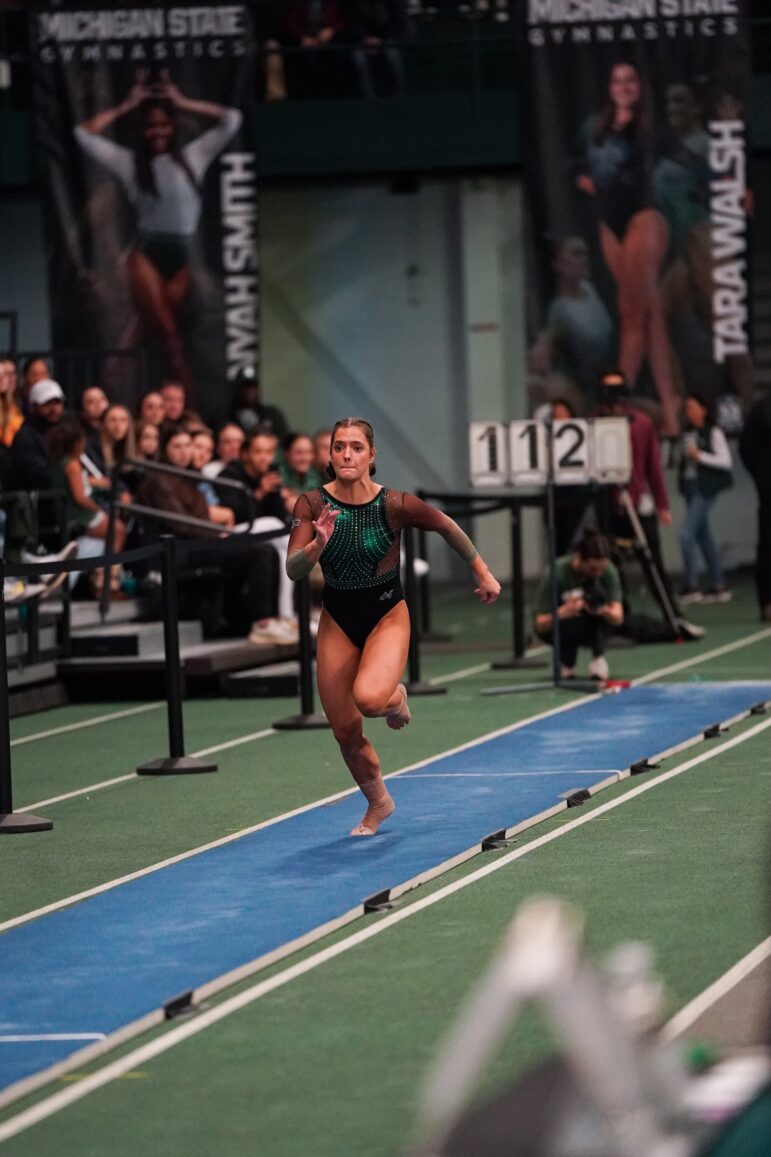
Erin Grady
Michigan State gymnastics stayed undefeated in conference play on Sunday with a 197.550-195.525 win against the No. 25 Maryland Terrapins.
“I feel really good about our position,” head coach Mike Rowe said.
No. 10 MSU now moves to 8-3 overall and 5-0 against the Big Ten.
The win was spurred by a 49.575 on the uneven bars for the Spartans, marking the second-highest score for the event in program history. Junior Skyla Schulte, junior Gabi Stephen, and sophomore Sage Kellerman all had season highs on the bars. Stephen and Kellerman had the highest scores for the bars during the meet, both scoring 9.950s.
“It felt amazing,” Rowe said about seeing his team’s performance during the second rotation.
MSU had a gymnast on top of the podium in all four events and the all-around category. Freshman MaKalya Tucker’s 9.900 led the way on the vault. Sophomore Nikki Smith shared first with Maryland’s Alexa Rothenbuescher with a 9.900. Schulte had a 9.950 on the beam, tying her career best, and ended the meet with a season-high all-around score of 39.600.
The Spartans put on their second-best output of the season in their final performance before the Big Five Meet on Feb. 23, one of the most important days of the season. The 197.550 is tied for the eighth-best score in program history. It also marks another sign of improvement throughout the year. After scoring 196.725 in their first meet of the year, Michigan State has scored at least 197.400 in each of its performances since.
Despite this, this team is not a complete product.
“I feel like we’re not hitting on all cylinders,” Rowe said.
There was one specific area he pointed out as a place to improve.
“It’s landings, landings, landings,” Rowe said. “I mean, floor, we’re pretty consistent on nailing landings. Vault, we hit, miss maybe 50%. Bars, about 50%. Beam has been pretty good on sticking them.”
The program is also awaiting its first National Qualifying Score (NQS) to be released. The NQS is what the NCAA uses to decide what 36 teams are allowed to compete for a national championship.
Up until this point, rankings were made simply from each team’s average score. The NQS works differently in that it takes the top six performances for each squad, three of which must be on the road, takes the top one off, and averages the remaining five out.
“I don’t know if this is a good thing, but [I check the rankings] daily,” Rowe said.
The Spartans will almost certainly compete in the NCAA Regionals, but the Spartans do have a natural interest in knowing where they stand. They fell just short of qualifying for the NCAA Semifinals last year, something only eight teams get to go to. At 10th, they still sit on that border between earning one of those spots and not. MSU was also the 10 seed in the National Collegiate Gymnastics Championships last year.
Oklahoma won the national title last year and is No. 1 in the current rankings this year too. The Spartans fell to the Sooners at the Super 16 meet on Jan. 5. They’ve seen what champions look like up close. They have about a month and a half to reach that championship-caliber before NCAA Regionals begin on April 5.
Next, the Spartans travel to Penn State University for the Big Five meet on Feb. 23, where they will face No. 15 Minnesota, Nebraska, No. 13 Ohio State, and Rutgers. They return to Jenison Fieldhouse on March 1 for a meeting with New Hampshire.